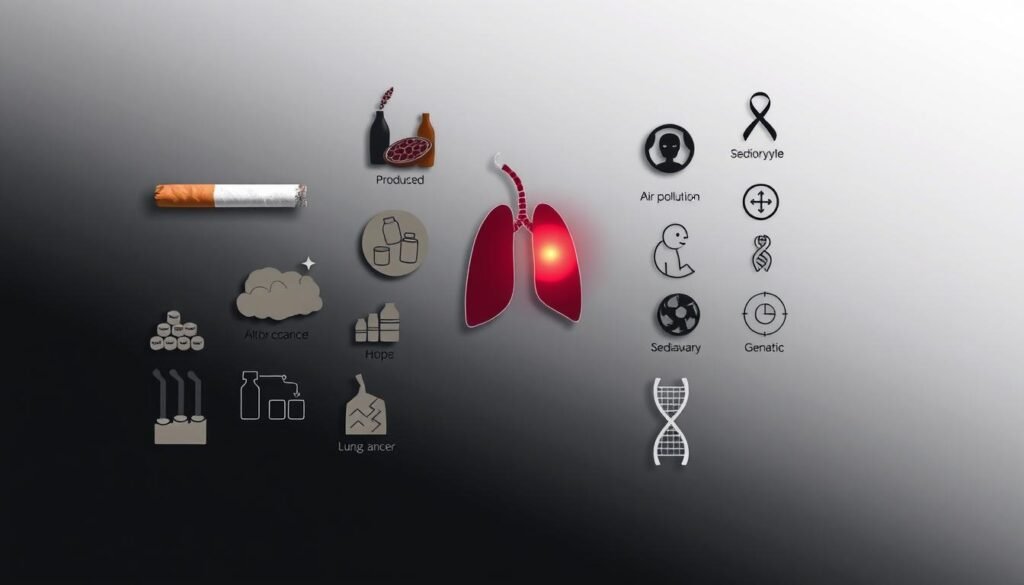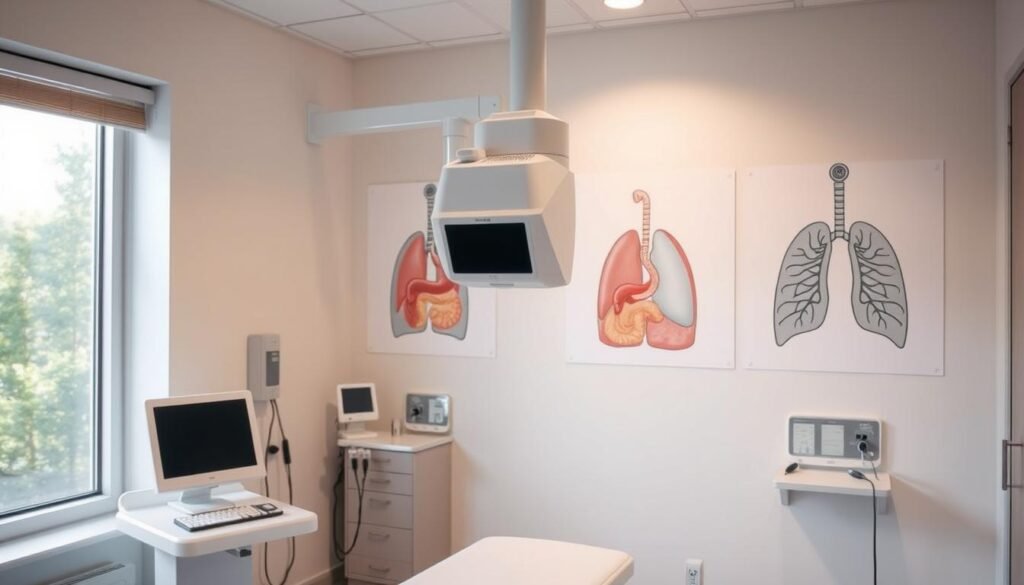Lung cancer leads in cancer deaths in the US, making up 1 in 5 cancer deaths. This fact shows the need for more awareness about colon and lung cancer. Both cancers are big health problems for many Americans every year.
Colon and lung cancer are not only common but also lead to many deaths. It’s important to know about their symptoms, risk factors, and how to screen and treat them. We aim to increase knowledge and encourage health checks to combat these cancers.
Key Takeaways
- Lung cancer is the top cause of cancer deaths in the U.S., with significant mortality rates.
- Colorectal cancer accounts for 10% of all cancer cases worldwide.
- Both cancers have distinct risk factors and symptoms that warrant attention.
- Early detection significantly improves survival rates.
- Screening and lifestyle choices play a key role in prevention.
Introduction to Colon and Lung Cancer
Colon and lung cancer are major health issues in the United States. It’s essential to keep educating people about colon cancer awareness. Knowing about these cancers helps in dealing with them and can even prevent them.
Lung cancer statistics from a study of over three thousand patients show a connection to colon cancer. This proves we need thorough screenings to catch cancer early. This can make treatments more effective. Many lung cancer cases had no symptoms and were found by accident.
Knowing about these cancers helps spot symptoms and risks early on. People with a family history or lifestyle risks must get checked regularly. Teaching people about cancer helps catch it early. This can lead to better survival rates and a better life.
Overview of Colon Cancer
Colorectal cancer is a common form of cancer found in the colon or rectum. It often starts as harmless polyps. It’s important to learn about cancer education and get regular screenings. This way, you can catch it early with the right cancer diagnostics. Early discovery means a better chance of beating it.
What is Colorectal Cancer?
Colorectal cancer begins in the tissues of the colon or rectum. It causes cells to grow uncontrollably in these areas. It’s the third most common cancer worldwide and the second leading cause of cancer deaths. By having regular screenings like colonoscopies, you can find and treat it early, greatly reducing the risk of it turning into cancer.
Statistics and Prevalence of Colorectal Cancer
Each year, the U.S. expects about 140,000 new cases of colorectal cancer, leading to 56,000 deaths. Colorectal cancer statistics show that rectal cancer makes up about 49.66% of these cases, while colon cancer makes up 49.09%. Thanks to better screening and treatments, more people are surviving this disease. There are slightly more men than women who get this cancer, with a ratio of 1.3:1.
People over 45 and those with a family history are at a higher risk. Lifestyle factors like lack of exercise and a high-fat diet also increase the risk. In countries like China, the rate of colorectal cancer often depends on the economic conditions of different areas.
Research is ongoing to find the best ways to diagnose and prevent colorectal cancer. It’s vital to raise awareness and encourage participation in screening programs. This approach can help reduce the number of deaths from colorectal cancer. Find out more about cancer diagnostics and how you can stay ahead.
Overview of Lung Cancer
Lung cancer is a major health issue in the U.S. It mainly comes in two types: small cell lung cancer (SCLC) and non-small cell lung cancer (NSCLC). Knowing the type is key for getting the right treatment and helping patients.
Types of Lung Cancer: SCLC and NSCLC
Small cell lung cancer makes up about 10% to 15% of all lung cancers. It grows and spreads fast, so finding it early is important. Often, SCLC has spread to other parts of the body by the time it’s found.
Non-small cell lung cancer is the most common, making up around 80% to 85% of cases. NSCLC has several subtypes:
- Adenocarcinoma: This is the most common kind, seen in smokers and non-smokers. It’s more common in women and the young.
- Squamous cell carcinoma: Often linked to smoking, it’s found mainly in the central lungs.
- Large cell carcinoma: This type grows fast and is hard to treat.
- Lung carcinoid tumors: These make up less than 5% of lung tumors and tend to grow slowly.
Statistics and Prevalence of Lung Cancer in the U.S.
Lung cancer is the second most common cancer in men and women. About 234,580 new cases are expected in 2024. It’s the top cause of cancer deaths in the U.S. Mostly older adults are affected, but lung cancer and death rates are dropping. This is thanks to fewer people smoking.
Knowing about lung cancer risks and types helps people make smart health choices. Here’s a table with key lung cancer stats:
| Type of Lung Cancer | Percentage of Cases | Characteristics |
|---|---|---|
| Small Cell Lung Cancer (SCLC) | 10% – 15% | Fast-growing, aggressive, often metastatic at diagnosis. |
| Non-Small Cell Lung Cancer (NSCLC) | 80% – 85% | Includes adenocarcinoma, squamous cell carcinoma, and large cell carcinoma. |
| Adenocarcinoma | Most common NSCLC | More frequent in women and non-smokers; associated with smoking history. |
| Squamous Cell Carcinoma | Common NSCLC | Linked to smoking; often found in central lungs. |
| Large Cell Carcinoma | Common NSCLC | Aggressive growth and rapid spread. |
| Lung Carcinoid Tumors | Less than 5% | Slow-growing with better prognosis. |
Risk Factors for Colon and Lung Cancer
It is vital to know the risk factors for colon and lung cancer. This knowledge is key for prevention and finding it early. Both cancers have common and unique risks that affect a person’s chances of getting sick.
General Risk Factors
Colon and lung cancers share several risk factors. Here are a few:
- Age: Being older than 50 increases the risk of colorectal cancer.
- Family history: Cancer in the family means you could be more at risk.
- Lifestyle risk factors: Diet, activity level, and smoking are big factors.
Maintaining a healthy lifestyle can lower some cancer risks.
Specific Risk Factors for Colorectal and Lung Cancer
Colorectal cancer risk is higher with certain genes and lifestyle choices. Having Lynch syndrome or familial adenomatous polyposis matters. So does having inflammatory bowel disease.
Lung cancer has its own risks. Most lung cancer deaths are linked to smoking. Smokers are much more likely to get lung cancer than non-smokers. Other specific risks for lung cancer include:
- Secondhand smoke: Even if you don’t smoke, being around it can raise your risk.
- Occupational hazards: Working with asbestos and diesel exhaust is dangerous.
- Air pollution: Dirty air increases health risks.
Lifestyle choices heavily influence colorectal cancer risk. Eating a lot of red and processed meat, being overweight, and having diabetes are risky. Staying aware of these factors is crucial for health.

Symptoms of Colon and Lung Cancer
Recognizing symptoms early improves treatment success for colorectal and lung cancer. It’s vital to know these warning signs for quick action and better health management. Here are the key symptoms for these cancers.
Common Symptoms of Colorectal Cancer
Colorectal cancer may not show symptoms right away, so knowing them is key. Look out for:
- Blood in stools, appearing bright red or dark.
- Changes in bowel movements, like ongoing diarrhea or constipation.
- Unexpected weight loss with weakness and fatigue.
- Stomach pain or cramps, signaling the need for a check-up.
Rectal bleeding and stool color change are critical. They often require quick medical checks to rule out cancer.
Common Symptoms of Lung Cancer
Lung cancer shows serious signs, often indicating it’s in a late stage. Key symptoms include:
- A cough that sticks around.
- Breathing issues and chest pain, suggesting big problems.
- Spitting blood, a major alarm for lung health.
- Weight loss or tiredness without reason, hinting at early cancer detection needs.
Acting fast on these signs leads to better disease control. Staying informed helps with early catching and better results. To learn more about these symptoms, visit this guide.
Colon and Lung Cancer Screening and Early Detection
Regular screenings are key to finding colon and lung cancers early. They help spot diseases before they get worse. Catching cancer early leads to better chances of beating it, which is crucial for staying healthy.
The Importance of Cancer Screening
Screening tests are really good at finding cancer early, especially lung cancer. The United States sees lung cancer as the second most common cancer. People between 50 to 80 who smoked a lot should get yearly lung cancer checks.
These checks use something called low-dose CT scans. They have been shown to save lives, especially in people at high risk.

Methods of Screening for Colorectal Cancer
Screening for colorectal cancer is very important because it’s both common and deadly. There are different ways to check for it, like:
- Fecal occult blood testing (FOBT)
- Colonoscopy
- Flexible sigmoidoscopy
These safe tests can spot early warning signs of cancer. Talking to a doctor can help you choose the best test. There are programs like the Population Health Colorectal Cancer Screening Program to help people get screened.
| Screening Method | Frequency | Effectiveness |
|---|---|---|
| Fecal Occult Blood Test | Annually | Identifies blood in the stool, a possible sign of cancer |
| Colonoscopy | Every 10 years | Allows for direct visualization and removal of polyps |
| Flexible Sigmoidoscopy | Every 5 years | Visualizes the lower part of the colon and can detect abnormalities |
Making these tests part of your regular health check-ups can greatly lower the risk of dying from colorectal cancer. Knowing your screening options can lead to a healthier life.
Cancer Treatment Options for Colon and Lung Cancer
Treatment for colon and lung cancer is customized for each patient. Knowing what treatments are available is key to managing the disease. We will discuss how to treat colorectal and lung cancers.
Treatment Options for Colorectal Cancer
Colorectal cancer treatments depend on the stage of the disease. For cancers caught early, removing the polyp through surgery may be all that’s needed. Sometimes, if cancer is found in the edges of the removed polyp, more surgery is needed.
- Stage 0: Surgery to remove the cancerous polyp is typically the only treatment needed.
- Stage I: Surgical interventions may be necessary if complete removal isn’t possible.
- Stage II: Involves surgery to eliminate cancer and nearby lymph nodes. Neoadjuvant chemotherapy may be recommended in certain cases.
- Stage III: Consists of surgery followed by adjuvant chemotherapy, commonly using regimens such as FOLFOX or CapeOx.
- Stage IV: Treatment may include surgery if feasible, followed by chemotherapy or targeted therapies.
After surgery, patients may receive adjuvant chemotherapy for 3 to 6 months. Treatments like 5-FU or capecitabine are common. Some may get immunotherapy based on their tumor’s genetics. Radiation therapy can help with symptoms in late-stage cancer but isn’t a cure.
Treatment Options for Lung Cancer
The treatment for lung cancer depends on its type and stage. Options include surgery, chemotherapy, targeted therapies, and immunotherapy. Each method targets the cancer in different ways, depending on how advanced it is.
- Surgery: In early stages, removing the tumor can be key.
- Chemotherapy: Helps shrink tumors and ease symptoms.
- Targeted therapies: Focus on specific mutations for better outcomes.
- Immunotherapy: Uses the immune system to attack cancer, showing promise for some patients.
Personalized care is crucial in cancer treatment, helping ensure the best results with fewer side effects. Understanding the various treatments available helps patients and their families make informed decisions with their healthcare providers.
| Stage | Treatment Options | Key Considerations |
|---|---|---|
| Stage 0 | Surgery | Polyp removal sufficient |
| Stage I | Surgery | Further surgery if needed |
| Stage II | Surgery & Neoadjuvant therapy | Consider chemotherapy for high-risk |
| Stage III | Surgery & Adjuvant chemotherapy | Regimens like FOLFOX are commonly used |
| Stage IV | Surgery (if feasible) & Chemotherapy | Targeted therapies based on tumor genetics |
Preventive Measures for Colon and Lung Cancer
Being proactive about cancer prevention cuts down the risk for colon and lung cancer. Healthy lifestyle changes can greatly improve health and well-being. Each person has a key role in using early prevention strategies.
Healthy Lifestyle Choices
Healthy habits can lower the chances of colon and lung cancer. Some top choices are:
- Eating a diet rich in fruits, veggies, and whole grains.
- Exercising regularly: 150 minutes of moderate or 75 minutes of intense activity weekly.
- Drinking less alcohol, sticking to one or two drinks per day.
- Avoiding all tobacco products, as they greatly increase cancer risk.
- Maintaining a healthy weight to reduce cancer risk.
Cancer Prevention Strategies
Preventing cancer requires a broad approach that boosts awareness and supports regular checks. Crucial strategies include:
- Educating the public on cancer risks and early warning signs.
- Urging regular screenings from 45 for colorectal cancer.
- Encouraging diets high in fiber and low in red meat to cut colon cancer risk.
- Promoting regular self-exams and doctor visits for personalized screening plans.
- Discussing the benefits of daily vitamins, especially multivitamins with folic acid, for lower risk.

| Lifestyle Choice | Impact on Cancer Risk |
|---|---|
| Balanced Diet | Reduces risk of colon cancer |
| Regular Exercise | Decreases risk of obesity-related cancers |
| Tobacco Avoidance | Lowers risk of multiple cancer types |
| Alcohol Limitation | Reduces risk of colorectal cancer |
| Healthy Weight Maintenance | Lowers risk of various cancer types, including colon |
Challenges in Treatment and Management
Caring for survivors of colorectal cancer poses many hurdles. It impacts their life quality and healthcare needs. These cancer management challenges come from several
treatment barriers.
Barriers include limited healthcare access, financial issues, and a lack of healthcare resources. It’s crucial to overcome these obstacles. Doing so ensures timely and effective cancer treatment.
Barriers to Effective Treatment
Getting the right treatment is a big worry. Patients face problems like not being able to reach treatment centers. They also struggle with no clear way to see specialists.
Money issues, such as insurance and costs, add to these problems. These treatment barriers may delay necessary early care. This delay can affect the success of treatments started.
The Importance of Supportive Care
Supportive care is key in boosting patient outcomes. It tackles physical, emotional, and psychological issues. This holistic treatment approach betters life quality and helps patients stick to their treatment plans.
Support involves mental health, nutrition advice, and help with treatment challenges. Blending these services improves survival chances and makes treatment more positive. Addressing these areas stresses the need for a united care approach for all cancer patients. For more on cancer survivors’ psychosocial needs, see this resource.
Conclusion
Understanding colon and lung cancer is key to raising awareness. Education on risk factors, signs, tests, and treatments helps people make smart health choices. This awareness doesn’t just help individuals; it makes the whole community healthier by fighting cancer better.
A lot of lung cancer cases are advanced when found. This fact highlights the importance of early detection. Knowing the signs and getting regular checks can catch the disease early, which is crucial.
Dealing with cancer treatment is hard, but knowing about colon and lung cancer helps. Patients and their families learn how to manage the disease effectively. With the right education and support, facing cancer gets a bit easier, improving outcomes and uniting us in the battle against cancer.